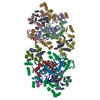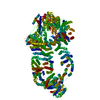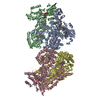+ Open data
Open data
- Basic information
Basic information
| Entry | Database: PDB / ID: 6c66 | |||||||||
|---|---|---|---|---|---|---|---|---|---|---|
| Title | CRISPR RNA-guided surveillance complex, pre-nicking | |||||||||
 Components Components |
| |||||||||
 Keywords Keywords | DNA BINDING PROTEIN/DNA/RNA / CRISPR-Cas / Cascade / Cas3 / DNA BINDING PROTEIN / DNA BINDING PROTEIN-DNA-RNA complex | |||||||||
| Function / homology |  Function and homology information Function and homology informationnuclease activity / maintenance of CRISPR repeat elements / defense response to virus / RNA helicase activity / hydrolase activity / RNA binding / ATP binding / metal ion binding / identical protein binding Similarity search - Function | |||||||||
| Biological species |   Thermobifida fusca (bacteria) Thermobifida fusca (bacteria) | |||||||||
| Method | ELECTRON MICROSCOPY / single particle reconstruction / cryo EM / Resolution: 3.66 Å | |||||||||
 Authors Authors | Xiao, Y. / Luo, M. / Liao, M. / Ke, A. | |||||||||
| Funding support |  United States, 2items United States, 2items
| |||||||||
 Citation Citation |  Journal: Science / Year: 2018 Journal: Science / Year: 2018Title: Structure basis for RNA-guided DNA degradation by Cascade and Cas3. Authors: Yibei Xiao / Min Luo / Adam E Dolan / Maofu Liao / Ailong Ke /  Abstract: Type I CRISPR-Cas system features a sequential target-searching and degradation process on double-stranded DNA by the RNA-guided Cascade (CRISPR associated complex for antiviral defense) complex and ...Type I CRISPR-Cas system features a sequential target-searching and degradation process on double-stranded DNA by the RNA-guided Cascade (CRISPR associated complex for antiviral defense) complex and the nuclease-helicase fusion enzyme Cas3, respectively. Here, we present a 3.7-angstrom-resolution cryo-electron microscopy (cryo-EM) structure of the Type I-E Cascade/R-loop/Cas3 complex, poised to initiate DNA degradation. Cas3 distinguishes Cascade conformations and only captures the R-loop-forming Cascade, to avoid cleaving partially complementary targets. Its nuclease domain recruits the nontarget strand (NTS) DNA at a bulged region for the nicking of single-stranded DNA. An additional 4.7-angstrom-resolution cryo-EM structure captures the postnicking state, in which the severed NTS retracts to the helicase entrance, to be threaded for adenosine 5'-triphosphate-dependent processive degradation. These snapshots form the basis for understanding RNA-guided DNA degradation in Type I-E CRISPR-Cas systems. | |||||||||
| History |
|
- Structure visualization
Structure visualization
| Movie |
 Movie viewer Movie viewer |
|---|---|
| Structure viewer | Molecule:  Molmil Molmil Jmol/JSmol Jmol/JSmol |
- Downloads & links
Downloads & links
- Download
Download
| PDBx/mmCIF format |  6c66.cif.gz 6c66.cif.gz | 805.6 KB | Display |  PDBx/mmCIF format PDBx/mmCIF format |
|---|---|---|---|---|
| PDB format |  pdb6c66.ent.gz pdb6c66.ent.gz | 650.5 KB | Display |  PDB format PDB format |
| PDBx/mmJSON format |  6c66.json.gz 6c66.json.gz | Tree view |  PDBx/mmJSON format PDBx/mmJSON format | |
| Others |  Other downloads Other downloads |
-Validation report
| Summary document |  6c66_validation.pdf.gz 6c66_validation.pdf.gz | 1.1 MB | Display |  wwPDB validaton report wwPDB validaton report |
|---|---|---|---|---|
| Full document |  6c66_full_validation.pdf.gz 6c66_full_validation.pdf.gz | 1.2 MB | Display | |
| Data in XML |  6c66_validation.xml.gz 6c66_validation.xml.gz | 124.8 KB | Display | |
| Data in CIF |  6c66_validation.cif.gz 6c66_validation.cif.gz | 192.6 KB | Display | |
| Arichive directory |  https://data.pdbj.org/pub/pdb/validation_reports/c6/6c66 https://data.pdbj.org/pub/pdb/validation_reports/c6/6c66 ftp://data.pdbj.org/pub/pdb/validation_reports/c6/6c66 ftp://data.pdbj.org/pub/pdb/validation_reports/c6/6c66 | HTTPS FTP |
-Related structure data
| Related structure data |  7347MC M: map data used to model this data C: citing same article ( |
|---|---|
| Similar structure data |
- Links
Links
- Assembly
Assembly
| Deposited unit | 
|
|---|---|
| 1 |
|
- Components
Components
-Protein , 2 types, 3 molecules GIK
| #1: Protein | Mass: 104039.219 Da / Num. of mol.: 1 Source method: isolated from a genetically manipulated source Source: (gene. exp.)   Thermobifida fusca (strain YX) (bacteria) Thermobifida fusca (strain YX) (bacteria)Strain: YX / Gene: Tfu_1593 / Production host:  |
|---|---|
| #4: Protein | Mass: 27446.613 Da / Num. of mol.: 2 Source method: isolated from a genetically manipulated source Source: (gene. exp.)   Thermobifida fusca (strain YX) (bacteria) Thermobifida fusca (strain YX) (bacteria)Strain: YX / Gene: Tfu_1591 / Production host:  |
-CRISPR-associated protein, ... , 4 types, 9 molecules ABCDEFHMO
| #2: Protein | Mass: 61433.297 Da / Num. of mol.: 1 Source method: isolated from a genetically manipulated source Source: (gene. exp.)   Thermobifida fusca (strain YX) (bacteria) Thermobifida fusca (strain YX) (bacteria)Strain: YX / Gene: Tfu_1592 / Production host:  | ||||
|---|---|---|---|---|---|
| #3: Protein | Mass: 41043.043 Da / Num. of mol.: 6 Source method: isolated from a genetically manipulated source Source: (gene. exp.)   Thermobifida fusca (strain YX) (bacteria) Thermobifida fusca (strain YX) (bacteria)Strain: YX / Gene: Tfu_1590 / Production host:  #7: Protein | | Mass: 28279.260 Da / Num. of mol.: 1 Source method: isolated from a genetically manipulated source Source: (gene. exp.)   Thermobifida fusca (strain YX) (bacteria) Thermobifida fusca (strain YX) (bacteria)Strain: YX / Gene: Tfu_1589 / Production host:  #9: Protein | | Mass: 26327.938 Da / Num. of mol.: 1 Source method: isolated from a genetically manipulated source Source: (gene. exp.)   Thermobifida fusca (strain YX) (bacteria) Thermobifida fusca (strain YX) (bacteria)Strain: YX / Gene: Tfu_1588 / Production host:  |
-DNA chain , 2 types, 2 molecules LN
| #6: DNA chain | Mass: 16801.725 Da / Num. of mol.: 1 / Source method: obtained synthetically / Source: (synth.)   Thermobifida fusca (bacteria) Thermobifida fusca (bacteria) |
|---|---|
| #8: DNA chain | Mass: 17099.920 Da / Num. of mol.: 1 / Source method: obtained synthetically / Source: (synth.)   Thermobifida fusca (bacteria) Thermobifida fusca (bacteria) |
-RNA chain / Non-polymers , 2 types, 3 molecules J

| #10: Chemical | | #5: RNA chain | | Mass: 19790.793 Da / Num. of mol.: 1 Source method: isolated from a genetically manipulated source Source: (gene. exp.)   Thermobifida fusca (bacteria) / Production host: Thermobifida fusca (bacteria) / Production host:  |
|---|
-Experimental details
-Experiment
| Experiment | Method: ELECTRON MICROSCOPY |
|---|---|
| EM experiment | Aggregation state: PARTICLE / 3D reconstruction method: single particle reconstruction |
- Sample preparation
Sample preparation
| Component | Name: CRISPR RNA-guided surveillance complex with Cas3 bound in its pre-nicking state Type: COMPLEX / Entity ID: #1-#9 / Source: RECOMBINANT |
|---|---|
| Source (natural) | Organism:   Thermobifida fusca (strain YX) (bacteria) Thermobifida fusca (strain YX) (bacteria) |
| Source (recombinant) | Organism:  |
| Buffer solution | pH: 7.5 / Details: 10 mM HEPES pH 7.5, 150 mM NaCl, 5 mM DTT |
| Specimen | Conc.: 1 mg/ml / Embedding applied: NO / Shadowing applied: NO / Staining applied: NO / Vitrification applied: YES |
| Specimen support | Grid material: COPPER / Grid type: Quantifoil R1.2/1.3 |
| Vitrification | Instrument: GATAN CRYOPLUNGE 3 / Cryogen name: ETHANE / Humidity: 85 % |
- Electron microscopy imaging
Electron microscopy imaging
| Experimental equipment |  Model: Tecnai Polara / Image courtesy: FEI Company |
|---|---|
| Microscopy | Model: FEI POLARA 300 |
| Electron gun | Electron source:  FIELD EMISSION GUN / Accelerating voltage: 300 kV / Illumination mode: FLOOD BEAM FIELD EMISSION GUN / Accelerating voltage: 300 kV / Illumination mode: FLOOD BEAM |
| Electron lens | Mode: BRIGHT FIELD / Nominal magnification: 31000 X / Calibrated defocus min: 1000 nm / Calibrated defocus max: 2700 nm / Cs: 2 mm |
| Specimen holder | Cryogen: NITROGEN / Specimen holder model: GATAN LIQUID NITROGEN / Temperature (max): 105 K / Temperature (min): 80 K |
| Image recording | Electron dose: 8 e/Å2 / Detector mode: COUNTING / Film or detector model: GATAN K2 SUMMIT (4k x 4k) / Num. of real images: 1428 |
- Processing
Processing
| Software | Name: PHENIX / Version: 1.11.1_2575: / Classification: refinement | ||||||||||||||||||||||||||||||||||||||||||||
|---|---|---|---|---|---|---|---|---|---|---|---|---|---|---|---|---|---|---|---|---|---|---|---|---|---|---|---|---|---|---|---|---|---|---|---|---|---|---|---|---|---|---|---|---|---|
| EM software |
| ||||||||||||||||||||||||||||||||||||||||||||
| CTF correction | Type: PHASE FLIPPING AND AMPLITUDE CORRECTION | ||||||||||||||||||||||||||||||||||||||||||||
| Particle selection | Num. of particles selected: 322268 | ||||||||||||||||||||||||||||||||||||||||||||
| 3D reconstruction | Resolution: 3.66 Å / Resolution method: FSC 0.143 CUT-OFF / Num. of particles: 51889 / Symmetry type: POINT | ||||||||||||||||||||||||||||||||||||||||||||
| Atomic model building | Protocol: OTHER | ||||||||||||||||||||||||||||||||||||||||||||
| Refine LS restraints |
|
 Movie
Movie Controller
Controller












 PDBj
PDBj
































































